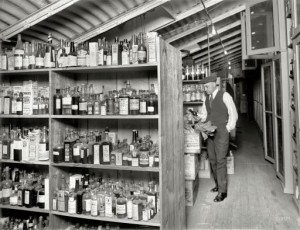Jamaican Ginger aka “Jake”
Jamaican Ginger aka “Jake” was a medication available in the 19th century. During prohibition, Jamaican Ginger aka “Jake” became a convenient way to get around laws preventing the sale of alcohol because it contains 70-80 % ethanol by volume.
Jamaican Ginger aka “Jake”: History
During the 1920’s and 1930’s, many pharmacies provided Jamaican Ginger aka “Jake.” The medicine came with claims of treating minor colds, headaches, menstrual cramps, and digestive problems. After the stock market collapse of 1929, Jamaican Ginger aka “Jake” became increasingly popular as a low-cost alternative to buying expensive bootlegged liquor.
Jamaican Ginger aka “Jake”: Jake Leg
By early 1930, a confusing new illness began spreading across the country. It was characterized by aching calf muscles, numbness in the legs and eventual loss of sensation. The disease progressed into muscle weakness and paralysis which was sometimes irreversible. Over the first six months of 1930, more than 600 cases were reported throughout the United States. Doctors were perplexed. What was causing this bizarre sudden paralysis?
The culprit, it turned out, was Jamaican Ginger aka “Jake.” This was considered odd at first because Jamaican Ginger aka “Jake” had been sold for decades and there had never been any reported problems. The condition became known as “jake leg.”
Jamaican Ginger aka “Jake”: Mystery Solved
Authorities had long been suspicious that people would use products like Jamaican Ginger aka “Jake” to circumvent prohibition. In an effort to avoid that, the U.S. Treasury Department required formulations of Jamaican Ginger aka “Jake to contain a certain amount of ginger solids per cubic centimeter of alcohol. The increased ginger content made it very bitter and difficult to drink. They figured people would be less inclined to abuse it.
Regulators tested Jamaican Ginger aka “Jake” by boiling it down and measuring the amount of solids left over. But some clever manufacturers figured out ways to fool the government tests. They would add castor oil or molasses to replace the ginger solids. Their formulations only contained a small amount of ginger, so they were easy to drink.
Then a Harry Gross and Max Reisman came along. They wanted to find another substance that would fool the government’s boiling tests but also provide a “kick” to the alcohol content. They decided on tri-orthocresal phosphate (TOCP), an industrial plasticizer. TOCP was originally thought to be non-toxic, but later it was shown to have a neurotoxic effect in humans and animals.
Gross and Reisman went into mass production of Jamaican Ginger aka “Jake” in 1930. They made thousands of bottles. Due to investigations of cases of “jake leg,” the bootleggers were indicted in December of that same year. Gross served a two year sentence while Reisman avoided serving any jail time.
Sadly, many of the victims of jake leg were people with very little political influence like immigrants, migrants, or itinerants, so they never received any kind of compensation for their injuries. The company that manufactured the Jamaican Ginger aka Jake was bankrupt, and attempts to petition Congress for financial support failed. The epidemic was especially common among lower-class African-American men, many of whom were not allowed in hospitals where they might have sought treatment. There was an extreme amount of stigma attached to sufferers of jake leg.


